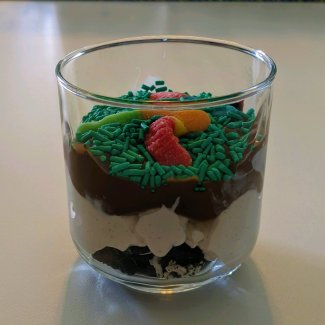Have you ever wondered what is below the top layer of soil outside? If you dig deep enough to see a large cross-section of soil, you might notice that the soil changes colors and is made up of different materials. Soil scientists have done a lot of research over the years, and they’ve told us that soil profiles can change from place to place depending on where you live, what your climate is, etc. Today, we are going to go over the basic layers of a soil profile – and make a tasty snack while we do so!
Find a helpful video on how to create your edible soil profile below:

Materials
- Clear Cup (glass or plastic)
- Sandwich Cookies (one whole cookie and one crumbled cookie per cup)
- Vanilla or White Chocolate Pudding
- Chocolate Pudding
- Sprinkles
- Gummy Worms
- Spoon(s)
- Paper Towel/Wash Cloth
Instructions
- Gather all your supplies in an area where it won’t hurt if it gets a little dirty.
- Before you start layering, show the students/kids a picture of a soil profile. Talk about how each layer, or horizon, is made up of different materials like rocks, sand, clay, roots, worms, and much more.
- Start layering your soil profile in your clear cup, explaining each layer/horizon as you go:
- Bedrock (whole sandwich cookie): The bedrock is a layer of rock that is found deep beneath some soils. In some parts of the world, the layers on top of the bedrock have been blown or worn away, so that is all that is left!
- C Horizon/Parent Material (crumbled sandwich cookie pieces): The C horizon is made up of rock pieces. These pieces are also called parent material, because some day they will break up to become smaller and smaller. Once they are small enough, they become soil.
- B Horizon/Subsoil (vanilla or white chocolate pudding): The B horizon, or subsoil, contains soil that doesn’t have much organic matter. Organic matter is all of the living things that help plants grow, like decomposing leaves, fungi, bacteria, worms, etc. This layer of soil is really hard to grow plants, trees, or crops in.
- A Horizon/Topsoil (chocolate pudding): The A horizon has all of the same things that the B horizon has, but it also has organic matter that helps plants grow. The organic matter makes the soil in the A horizon much darker than the soil in the B horizon.
- O Horizon/Organic Ground Cover (sprinkles): The O horizon has things that are growing in the soil, like grass.
- Lastly, you can have the students/kids throw a few gummy worms in. It is important for us to have living things in the soil like worms, bugs, fungi, and bacteria to help the plants grow and keep water and nutrients close to the roots.
- Use a spoon and “dig” in – you’ve made an edible soil profile! While you are eating, you can ask some of these questions to check for understanding:
- Sometimes, if you move soil around too much, the top layer (topsoil) can blow away. Why would it be bad if that layer of soil disappeared? (ANSWER: It is much harder to grow plants in the lower levers of a soil profile vs. the topsoil.)
- Can you name all the layers of soil? (ANSWER: bedrock, C horizon/parent material, B horizon/subsoil, A horizon/topsoil, O horizon/organic ground cover.)
- Why is the A horizon darker than the B horizon? (ANSWER: The A horizon has organic matter that makes the soil healthier and darker.)
- What layer of the soil is the most important to keeping us alive? (ANSWER: The A horizon/topsoil, because that is where all of our plants grow their roots.)
Thinking Thursday projects will be posted each Thursday (except for holidays) throughout the museum closure for COVID-19. For a full list of previous projects, visit Thinking Thursday.
Questions? Contact Sarah, the museum's education coordinator.

